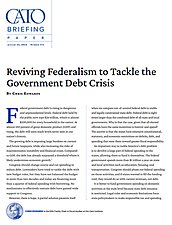1. Statistical studies find that government debt above about 90 percent of gross domestic product reduces economic growth. Chris Edwards, “America in Debt Damage Zone,” Cato at Liberty (blog), Cato Institute, October 19, 2021.
2. “Monthly Budget Review: Summary for Fiscal Year 2023,” Congressional Budget Office, November 8, 2023.
3. Thomas Jefferson, letter to John Taylor, Founders Online, National Archives, November 26, 1798.
4. Romina Boccia has reviewed past federal budget reforms and proposed a better strategy. Romina Boccia, “How a Better Budget Control Act Would Limit Spending and Control Debt,” Cato Institute Briefing Paper no. 156, May 11, 2023.
5. “2021 State & Local Government Finance Historical Datasets and Tables,” Census Bureau, last revised September 7, 2023.
6. Moody’s Investors Service, “Ability to Service Long‐Term Liabilities and Fixed Costs Improves,” September 26, 2023.
7. The requirements generally cover the general and education funds. However, federal funds and other funds with dedicated revenue sources are typically balanced automatically.
8. Kathryn Vesey White et al., Budget Processes in the States (Washington: National Association of State Budget Officers, Spring 2021), p. 48.
9. National Conference of State Legislatures, “NCSL Brief: State Balanced Budget Provisions,” October 2010, p. 2.
10. Kathryn Vesey White et al., Budget Processes in the States (Washington: National Association of State Budget Officers, Spring 2021), p. 48.
11. National Conference of State Legislatures, “NCSL Fiscal Brief: State Balanced Budget Provisions,” October 2010, p. 7.
12. Kathryn Vesey White et al., Budget Processes in the States (Washington: National Association of State Budget Officers, Spring 2021), p. 49. Other sources have somewhat different state counts.
13. Burton W. Folsom Jr. and Anita Folsom, “The Boy Governor Endorses State Subsidies,” chap. 3 in Uncle Sam Can’t Count (New York: Broadside Books, April 2014).
14. Julie A. Roin, “Privatization and the Sale of Tax Revenues,” Minnesota Law Review 95, no. 6 (2011): 1975.
15. These are Georgia, Maryland, Minnesota, New York, and Rhode Island.
16. “How the Fiscal Responsibility Act of 2023 Affects CBO’s Projections of Federal Debt,” Congressional Budget Office, June 2023.
17. Michael Streepey et al., Capital Budgeting in the States (Washington: National Association of State Budget Officers, Spring 2014), p. 90.
18. Kathryn Vesey White et al., The Fiscal Survey of States (Washington: National Association of State Budget Officers, Spring 2023), p. 68.
19. John Hicks, Executive Director, National Association of State Budget Officers, Testimony Before the Senate Budget Committee, 116th Cong., 1st sess., June 19, 2019, p. 4.
20. Kathryn Vesey White et al., Budget Processes in the States (Washington: National Association of State Budget Officers, Spring 2021), p. 47.
21. Moody’s Investors Service, “Ability to Service Long‐Term Liabilities and Fixed Costs Improves,” September 26, 2023, p. 13.
22. For state obligations, see Marc Joffe, “Survey of State & Local Government OPEB Liabilities,” Reason Foundation, February 22, 2021. For federal obligations, see “Financial Report of the United States Government: Fiscal Year 2022,” Department of the Treasury, February 16, 2023, p. 199. This is the infinite horizon estimate.
23. I am counting federal aid to the states as federal spending in this ratio, not as state spending.
24. Calculations based on National Accounts of OECD Countries: General Government Accounts 2022 (Paris: OECD Publishing, 2023).
25. The Canadian federal government, however, does help to fund schools for Indigenous peoples.
26. Chris Edwards, “Restoring Responsible Government by Cutting Federal Aid to the States,” Cato Institute Policy Analysis no. 868, May 20, 2019.
27. Office of Management and Budget, Analytical Perspectives: Budget of the US Government, Fiscal Year 2024 (Washington: Government Publishing Office, 2023), p. 78. Total official aid to states in 2023 was $1.1 trillion, to which I’ve added Supplemental Nutrition Assistance Program benefits and project‐based rental aid.
28. Chris Edwards and Michael Cannon, “Medicare Reforms,” Downsizing the Federal Government, September 1, 2010.
29. “Options for Reducing the Deficit, 2023 to 2032—Volume II: Smaller Reductions,” Congressional Budget Office, December 2022. See options 13 and 18. I’ve estimated values for 2033.
30. My savings are measured from the Congressional Budget Office’s baseline, which assumes that discretionary spending grows with inflation. To roughly estimate the 2033 amounts, I’ve inflated the non‐Medicaid 2023 values shown in Table 1.


